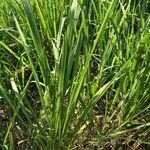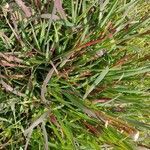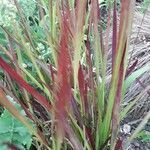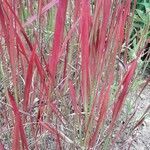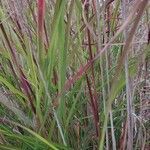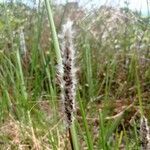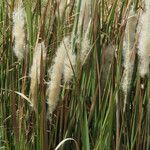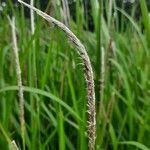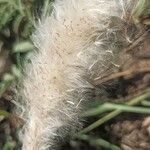Strongly rhizomatous perennial, 0.1-1.2 m high. Leaf blade up to 1500 x 2-12 mm, broad in middle, narrowed at apex and base, reddish in winter; ligule a fringed membrane. Inflorescence a dense, cylindrical, spike-like panicle, white to silvery due to long silky hairs from callus, spikelets paired, similar, unequally pedicelled. Spikelets 3-6 mm long, awnless, enveloped in long silky hairs from callus and glumes; glumes equal, similar, as long as spikelet. Florets 2; lower floret sterile, rarely male; upper floret bisexual; lemma less firm than glumes, hyaline; anther 3.0-3.5 mm long. Flowering time Aug.-June.
Perennial 100-1200 mm high; strongly rhizomatous. Leaf blade to 1500 x 2-12 mm, broad in middle, narrowed at apex and base, reddish in winter. Inflorescence a dense cylindrical spike-like panicle, white to silvery due to long silky hairs from callus. Spikelet 3-6 mm long, awnless; glumes as long as spikelet; anther 3.0-3.5 mm long.
A grass which keeps growing from year to year. It has rhizomes. The stems are smooth. They are hairy at the nodes. The leaves are flat and somewhat erect. They are 50 cm long. The flowers are silvery white panicles. They can be 20 cm long. Imperata cylindrica is usually 1 m tall. and Imperata exaltata is 2m.
Perennial; up to 1.2 m high; strongly rhizomatous; in dense stands. Culms erect. Leaf blades up to 1500 x 2-12 mm; broad in middle; narrowed at apex and base; reddish in winter. Flowers: panicle compact; cylindrical; silky; white; spikelets all alike; 3-6 mm long.
Perennial, strongly rhizomatous, up to 1.2 m high. Leaf blades up to 1500 mm long, 2-12 mm wide, leaves broad in middle, narrowed at tip and base, reddish in winter. Spikelets all alike, 3-6 mm long. Panicle dense, silky, white, cylindrical.
Strongly rhizomatous perennial to 1 m. Leaves linear-lanceolate, Spikelets in a dense, cylindrical, white-silky panicle, awnless.
